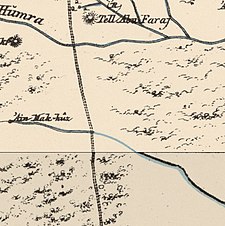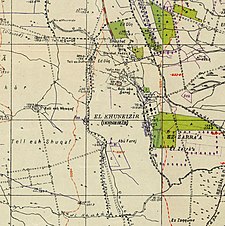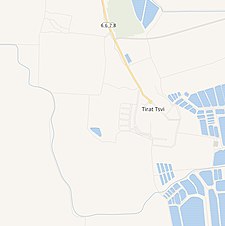Al-Khunayzir
الخنيزر 'Arab al Khuneizir
[1] | |
|---|---|
Village | |
| Etymology: Tell el Khaneizîr, the mound of the swine [2] | |
A series of historical maps of the area around Al-Khunayzir (click the buttons) | |
Location within
Mandatory Palestine | |
| Coordinates: 32°25′17″N 35°31′20″E / 32.42139°N 35.52222°E | |
| Palestine grid | 199/203 |
| Geopolitical entity | Mandatory Palestine |
| Subdistrict | Baysan |
| Date of depopulation | May 20, 1948 [1] |
| Area | |
| • Total | 3,107 dunams (3.107 km2 or 1.200 sq mi) |
| Population (1945) | |
| • Total | 260 [3] [4] |
| Cause(s) of depopulation | Influence of nearby town's fall [1] |
| Current Localities | Tirat Zvi [5] |
Al-Khunayzir ( Arabic: الخنيزر), was a Palestinian Arab village in the District of Baysan. It was depopulated during the 1948 Arab-Israeli War on May 20, 1948.
History
In 1881, a nearby tell was named as Tell el Khaneizîr, meaning the mound of the swine, and a nearby spring was named as Ain el Khaneizîr meaning the spring of the swine. [6] خنزير means pig in Arabic. [2]
British Mandate era
In the 1922 census of Palestine, conducted by the Mandatory Palestine authorities, Kunaizir had a population of 83; all Muslims, [7] increasing in the 1931 census to 200 Muslims, in a total of 47 houses. [8]
In the 1945 statistics the population was 260 Muslims, [3] with a total of 3,107 dunams of land. [4] Of this, 36 dunams were for citrus and bananas, 1,658 for plantations and irrigated land, 256 for cereals, [9] while 34 dunams were non-cultivable land. [10]
1948, and aftermath
According to B. Morris, 'Arab al Khuneizir was abandoned by its population under the "[i]nfluence of nearby town's fall", on 20 May 1948. [1]
In 1992 it was described: "The only remaining landmarks is a cemetery on Tall Abu al-Faraj (199/203), north of the site. To the north and the west of this tell are the springs of 'Uyun Umm al-Faraj and 'Ayn al-Khanazir. Most of the village site and the land around it are covered with palm trees." [5]
References
- ^ a b c d Morris, 2004, p. xvii, village #131. Also gives cause of depopulation
- ^ a b Palmer, 1881, p. 169
- ^ a b Government of Palestine, Department of Statistics, 1945, p. 6
- ^ a b c Government of Palestine, Department of Statistics. Village Statistics, April, 1945. Quoted in Hadawi, 1970, p. 43
- ^ a b Khalidi, 1992, p. 54
- ^ Palmer p.157
- ^ Barron, 1923, Table IX, p. 31
- ^ Mills, 1932, p. 79
- ^ Government of Palestine, Department of Statistics. Village Statistics, April, 1945. Quoted in Hadawi, 1970, p. 85
- ^ Government of Palestine, Department of Statistics. Village Statistics, April, 1945. Quoted in Hadawi, 1970, p. 135
Bibliography
- Barron, J.B., ed. (1923). Palestine: Report and General Abstracts of the Census of 1922. Government of Palestine.
- Government of Palestine, Department of Statistics (1945). Village Statistics, April, 1945.
- Hadawi, S. (1970). Village Statistics of 1945: A Classification of Land and Area ownership in Palestine. Palestine Liberation Organization Research Center. Archived from the original on 2018-12-08. Retrieved 2009-08-18.
- Khalidi, W. (1992). All That Remains:The Palestinian Villages Occupied and Depopulated by Israel in 1948. Washington D.C.: Institute for Palestine Studies. ISBN 0-88728-224-5.
- Mills, E., ed. (1932). Census of Palestine 1931. Population of Villages, Towns and Administrative Areas. Jerusalem: Government of Palestine.
- Morris, B. (2004). The Birth of the Palestinian Refugee Problem Revisited. Cambridge University Press. ISBN 978-0-521-00967-6.
- Palmer, E.H. (1881). The Survey of Western Palestine: Arabic and English Name Lists Collected During the Survey by Lieutenants Conder and Kitchener, R. E. Transliterated and Explained by E.H. Palmer. Committee of the Palestine Exploration Fund.
External links
- Welcome To al-Khunayzir
- al-Khunayzir, Zochrot
- Survey of Western Palestine, Map 9: IAA, Wikimedia commons





